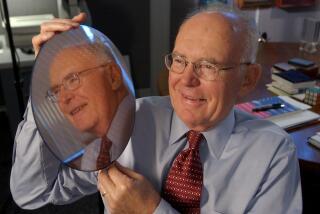Bell Labs’ Transistor Technology ‘Beyond State of the Art’
- Share via
Fifty years ago this month, researchers at Bell Laboratories in New Jersey invented the world’s first transistor, a sugar-cube-sized device that ushered in the era of modern electronics.
Next week, researchers from the same legendary lab plan to commemorate that bit of history by unveiling a breakthrough of their own: a transistor so small that billions of them could fit on a single model of the original.
It will be years before the new transistor can be replicated in mass production, but it could eventually make it possible to design a generation of computers, portable telephones and other devices that are far smaller and consume less power.
“I can imagine a watch-phone that gives you Internet access,” said Steve Hillenius, head of device research at Bell Labs, now a unit of Lucent Technologies Inc.
Hillenius and his team of scientists found a way to shrink the dimensions of a transistor to 0.06 micron, or about one-thousandth the width of a human hair and one-fourth the size of today’s state-of-the-art transistors.
The specifications of the transistor are scheduled to be unveiled at the International Electron Devices Meeting in Washington next Monday.
An important thing about the techniques used to produce the transistor is that they can eventually be employed by semiconductor industry giants such as Intel Corp., which is just now moving toward a standard of 0.25 micron.
Analysts said the Bell Labs technology is an important advance in the never-ending search for new ways to bear out Moore’s Law--the theorem that computer chips will double in capacity roughly every 18 months.
Linley Gwennap, editor of the Microprocessor Report newsletter, said Bell Labs’ new technology is “well beyond the state of the art.”
“The current thinking is with existing technology, we’re good for another five years on the Moore’s Law curve,” he said. “This new technology might be needed to go beyond that.”
Most recent advances in semiconductor research have centered on improvements in lithography--the use of light waves to etch microscopic patterns on chips of silicon.
But Bell Labs’ arcane new technology involves shaving--to the width of just three atoms--the thickness of the layers of oxide insulation used in chips. That in turn allows for similar reductions in the size of gates, sources and drains--the plumbing that manages the flow of electricity through the chip.
It could be used with various chip-making processes, including electron-beam or ultraviolet lithography.
“To build this ultra-thin oxide layer, the wafer you start with has to be absolutely flat,” Hillenius said. “You can’t have any atoms sticking up.”
Enough said.






